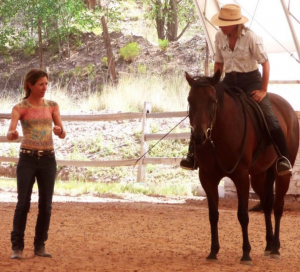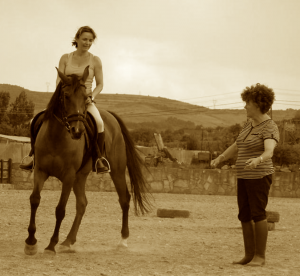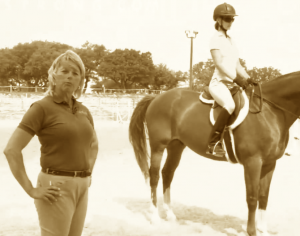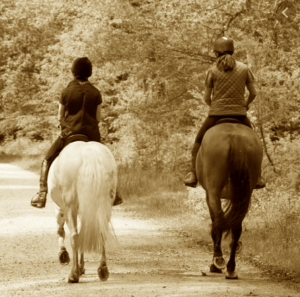 Editor’s Note: Best Horse Practices Summit presenter Katrin Silva grew up riding dressage in Germany before moving to the United States at age 19 to learn to ride Western. She’s been riding both disciplines for the last 20 years and is a regular guest columnist for Cayuse Communications. The author of Dressage for All of Us: How to Help Any Horse Become a Happier, More Responsive Riding Partner lives in New Mexico where she works with dressage and Western clients. Visit her blog here.
Editor’s Note: Best Horse Practices Summit presenter Katrin Silva grew up riding dressage in Germany before moving to the United States at age 19 to learn to ride Western. She’s been riding both disciplines for the last 20 years and is a regular guest columnist for Cayuse Communications. The author of Dressage for All of Us: How to Help Any Horse Become a Happier, More Responsive Riding Partner lives in New Mexico where she works with dressage and Western clients. Visit her blog here.
Katrin writes:
If you want to become a better rider, you will need help. Books, videos, and podcasts provide useful information, but they’re no substitute for working with a trainer on a regular basis. Progress is difficult without the one-on-one guidance and feedback an experienced professional can provide.
After 30 years of working with horses full-time, I still take lessons as often as I can. You should, too, but not every trainer is right for everyone. And not all great riders are good teachers, or good at working with horses that are different from what they’re used to.
To make things more complicated, professional horse trainers are humans, with different personalities and teaching styles. Finding the right match may require some trial and error, but there are a few phrases that I consider red flags. When you hear your trainer say one of these, take a step back. Ask for clarification. Ask her to explain. If she can’t, or if the explanation falls short of what you can accept, be prepared to ask yourself whether you want to work or to keep working with this person.
- “Crank that noseband tighter!” OR: “Use a twisted-wire snaffle!” OR “Let’s put him in draw reins.”
 These are shortcuts – ways to make a horse’s frame or rein contact look correct from the outside. Cranking a horse’s mouth shut and forcing him into a round frame via draw reins is the equivalent of putting duct tape over your car’s “check engine” light. It takes care of the irritating flash of red on your dashboard, but it won’t fix the underlying problem.
These are shortcuts – ways to make a horse’s frame or rein contact look correct from the outside. Cranking a horse’s mouth shut and forcing him into a round frame via draw reins is the equivalent of putting duct tape over your car’s “check engine” light. It takes care of the irritating flash of red on your dashboard, but it won’t fix the underlying problem.
If your horse is struggling with accepting contact, trying a different bit can help, but changing to a more severe bit because he doesn’t “respect” the milder version only teaches him that bits cause pain.
- “You need a different horse.” OR: “You would do so much better on this nice horse I happen to have for sale!”
I’ve said this a few times over the last 30 years, for legitimate reasons, like concern for an inexperienced rider’s safety, or when a horse’s athletic abilities are no match for his rider’s goals. If you want to compete in 100-mile endurance rides, a draft horse won’t get you there, and it would not be fair to ask him.
On the other hand, if you feel comfortable on your horse and have goals compatible with what he can do, why sell him? With enough time and effort, unlikely horse-rider pairs can develop into solid, harmonious partnerships. I stay away from buying and selling horses, mainly because I am no good at it, but also because it can create a financial conflict of interest, i.e. an incentive for me to discourage an owner to keep the horse she has now. I’d much rather help build a good horse-rider relationship than help break it up. Ask yourself whether your trainer is recommending a change of horses for a valid reason, or for a sketchy one, like a sales commission.
- “You are not a good enough rider for this horse.”
 Often, what follows is a variation of “Your talented horse would be so much better off with me, the trainer, riding him and showing him!”
Often, what follows is a variation of “Your talented horse would be so much better off with me, the trainer, riding him and showing him!”
If your horse experience is limited, and if your horse is green or has behavioral issues that make him unsafe for you to ride, it may be true.. But if your horse is a pleasure to ride, he can, with your trainer’s help, teach you to become a better rider.
Don’t buy into the argument that, if you keep riding your talented horse, he won’t reach his full potential as a show horse and will not be a happy horse. I love helping horses reach their potential, but the reality is horses don’t care about whether or not they win ribbons, as long as they are ridden in a way that’s comfortable and makes sense to them.
- “You have no idea how to ride.” OR” You will never be any good.”
Making students feel terrible about their riding is part of a common teaching strategy which comes from military boot camp training. Where I grew up, in Germany, riding schools used to be part of the cavalry, so the military style of teaching lingered for a long time. Some instructors still practice a version of “tear them down before you build them up.” Others tear students down because it makes them feel better.
But students can’t learn if they’re feeling terrible. A student without confidence can’t learn. Of course, the other extreme – teachers who never criticize their students because they don’t want to make them feel bad – is wrong, too. There is a middle ground where learning happens: a positive, constructive teaching style.
- “Your horse is stubborn/naughty/a piece of sh#t/bad horse.”
Translation: the trainer is frustrated and does not know how to help this horse, or help this rider get along with her horse. Abusive language about horses often leads to physical abuse of horses. I also don’t like to hear anyone talk about horses in generalizing terms. like: “all mares are bitchy/Arabians are crazy.”
We can describe behavior in a way that encourages solutions, instead of blaming the horse.
- “Because I’m the trainer, that’s why.”
 Stay away from trainers who don’t want to explain why they use the equipment they use, or the methods they use, or why they want you to change your position a certain way, or why they want your horse to practice certain exercises. I encourage my students to ask a lot of questions that start with “Why?”
Stay away from trainers who don’t want to explain why they use the equipment they use, or the methods they use, or why they want you to change your position a certain way, or why they want your horse to practice certain exercises. I encourage my students to ask a lot of questions that start with “Why?”
- “There’s no reason to be scared/apprehensive/doubtful/discouraged. Just do what I say!”
Riding is an emotional endeavor for most of us. Fear and anxiety can be real obstacles. Dismissing these emotions is counterproductive and disrespectful. Teaching is a two-way conversation. If a student has emotional issues that keep her from progressing, it’s part of her job to let me know about them. It’s my job to help her address them. If these issues go beyond what I can deal with, I may suggest the help of a good sport psychologist.
- “My colleague X is a bad trainer/has no idea what she is doing.” OR: “My other student X is a terrible rider.”
A trainer who talks badly about other riders or trainers will say bad things about you behind your back. You can bet on it. Some students feel like they belong to the trainer’s inner circle now. But we’ve grown up since middle school. Cliques are not cool.
- “Use your outside rein . . USE YOUR OUTSIDE REIN! USE YOUR OUTSIDE REIN!!!!”
Yelling is never good teaching. It does not improve our riding. Yelling is also disrespectful to the horses. They have sensitive ears. I really like to keep the tone at my barn civil and pleasant, between people as much as between horses and people. I think the horses like it better, even if they can’t understand the words.
- “Your horse needs a new saddle/ new supplement/new gadget-thingy . . . which I happen to sell and can give you a good deal on. If you don’t, you are an irresponsible, uncaring owner.”
This is another instance where selling something may create a conflict of interest. Yes, the saddle should fit, but there are many good options to improve saddle fit, from using a half-pad with shims to reflocking or adjusting the tree to purchasing a used saddle from a friend. Don’t let a trainer, or a saddle manufacturer’s customer service rep recommended by your trainer, tell you otherwise. You can be a responsible horse owner and not spend $5,000 on a new dressage saddle. The same goes for feed and supplements, for body work, therapeutic boots, etc.
This list begs the question: Why do trainers say such things?
Yes, a few trainers have their own interests in mind, not yours or your horse’s.
Yes, there are a few trainers who put others down to feel good about themselves. Some trainers are great riders, but not good teachers.
Most trainers are good people who choose this work because they love what they do. They might also find themselves immersed in an equestrian culture with firmly entrenched traditions, teaching styles, and business practices. They feel they need to sink or swim.
But there is another way. We can change. Let’s start with asking questions that start with “Why?”
Great article…GREAT ARTICLE! GRRREAT ARTICLE!!!!!